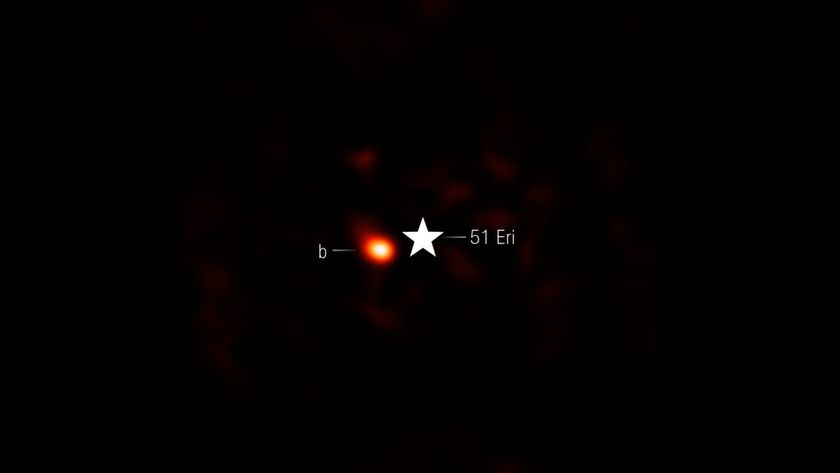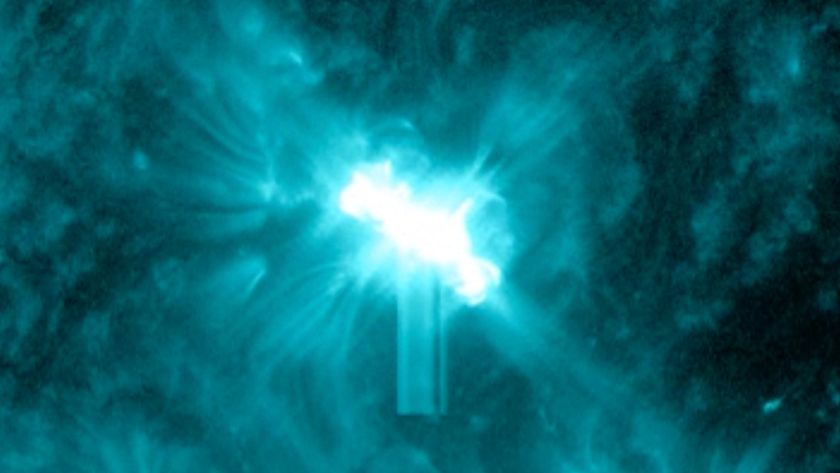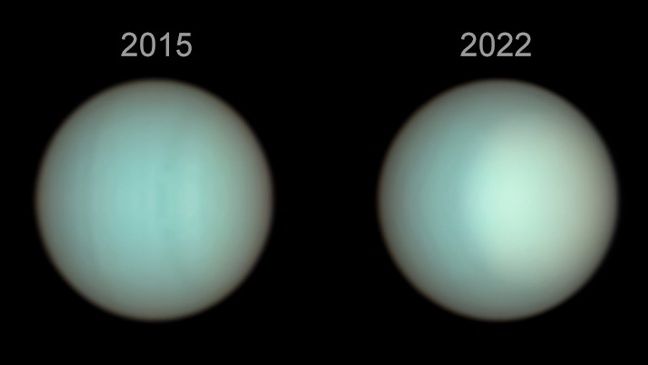SpaceX launches 60 new Starlink internet satellites into orbit, misses rocket landing
It was a rare miss for SpaceX's rocket landings.
CAPE CANAVERAL, Fla. — A SpaceX Falcon 9 rocket launched a new batch of 60 Starlink internet satellites into orbit late Monday (Feb. 15), but failed to stick its landing on a floating platform at sea.
The two-stage Falcon 9 booster, topped with the 60 broadband spacecraft, lifted off from Space Launch Complex 40 here at Cape Canaveral Space Force Station at 10:59 p.m. EST (0359 GMT on Feb. 16). Approximately nine minutes later, the rocket's first stage returned to Earth to attempt its sixth landing on SpaceX's drone ship "Of Course I Still Love You" in the Atlantic Ocean," but missed its target.
"It does look like we did not land our booster on Of Course I Still Love You tonight," SpaceX manufacturing engineer Jessica Anderson said during live launch commentary. "It is unfortunate that we did not recover this booster but our second stage is still on a nominal trajectory."
SpaceX prefers to recover its Falcon 9 rocket stages for reuse, but the company has also said repeatedly that delivering a flight's payload to orbit is always the primary mission.
Video: Watch SpaceX's Falcon 9 launch 60 Starlink satellites
Related: SpaceX's Starlink satellite megaconstellation in photos
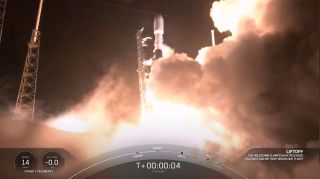
Space.com Collection: $26.99 at Magazines Direct
Get ready to explore the wonders of our incredible universe! The "Space.com Collection" is packed with amazing astronomy, incredible discoveries and the latest missions from space agencies around the world. From distant galaxies to the planets, moons and asteroids of our own solar system, you’ll discover a wealth of facts about the cosmos, and learn about the new technologies, telescopes and rockets in development that will reveal even more of its secrets.
One of SpaceX's frequent fliers powered this latest Starlink mission into orbit. The booster, dubbed B1059, previously ferried two different SpaceX Dragon cargo resupply missions to the International Space Station — CRS-19 in Dec. 2019 and CRS-20 in March of 2020 — a Starlink mission last June, an Earth-observing satellite for Argentina (SAOCOM-1B in August 2020), and a spy satellite for the U.S government as part of the NROL-108 mission in December.
Tonight's launch was the first of two planned Starlink liftoffs within a week; another 60 satellites are scheduled to take flight early as Wednesday (Feb. 17) on a different Falcon 9. The quick succession is due to the fact that SpaceX recently had to shuffle around its planned Starlink missions as both weather and hardware-related issues presented a bit of a challenge.
Get the Space.com Newsletter
Breaking space news, the latest updates on rocket launches, skywatching events and more!
This mission, dubbed Starlink 19, moved forward after SpaceX's 18th Starlink mission blasted off on Feb. 4. Both flights leapfrogged Starlink 17, which was originally slated to launch on Feb. 1. Scheduled to fly on one of SpaceX's two record-setting frequent fliers, B1049, the mission was delayed several times and is now expected to blast off just after midnight on Feb. 17.
During the initial mission planning, SpaceX targeted launching two Starlink missions just hours apart — a first for the space coast since 1966 when a Gemini rocket was followed by an Atlas Agena just 99 minutes later. Ultimately the dual missions did not happen, but in an unprecedented move for the era of commercial spaceflight, the Eastern Range (the agency that oversees launches along the East Coast) approved two missions to launch in quick succession.
This is a feat we may see happen at a later date, especially as more launch providers become active and more and more launches blast off from Florida. Last year, there were a record 31 launches for the year, and 2021 could be even busier as the 45th Space Wing is preparing for at least 40 missions.
Related: See the evolution of SpaceX's rockets in pictures
Double the launches
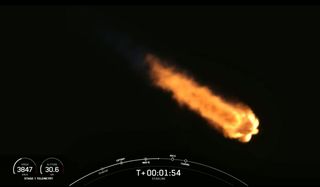
Originally slated to launch on Sunday night, SpaceX had to stand down due to poor weather at the launch site. Thunder storms rolled across Florida this past weekend, preventing the flight from taking off.
Conditions improved Monday and the Falcon 9 was able to fly, marking the fifth launch of the year for SpaceX and enabling the company to look forward to its next mission. Another stack of Starlink satellites is set to blast off from SpaceX's other Florida launch site at Pad 39A of NASA's Kennedy Space Center here.
The mission was also the 108th flight overall for SpaceX’s workhorse Falcon 9. It would have marked the 75th rocket landing for the company if the Falcon 9 had stuck its touchdown.
To recover its returning boosters, SpaceX uses two massive floating landing platforms — "Of Course I Still Love You" and "Just Read the Instructions" — in addition to its landing pads, which allow the company to launch (and land) more rockets. Typically the drone ships see most of the action as it takes more fuel reserves to land back in land than it does to land at sea.
The version of Falcon 9 we see today, is a souped-up version of its predecessors, capable of flying multiple times with only minor refurbishments in between. That's due to a series of upgrades Falcon 9 received in 2018 — including a more robust thermal protection system, titanium grid fins and a more durable interstage — which facilitate reuse.
As such, this fleet of more capable rockets has allowed SpaceX to fly more missions. The company launched a record 26 times in 2020, with 22 of those flights on veteran rockets.
The company aims to surpass that record in 2021, as it hopes to launch at least 40 rockets between its California and Florida launch facilities.
Building a megaconstellation
With tonight's launch success, SpaceX now has more than 1,000 Starlink satellites into orbit. And there are many more launches coming; SpaceX’s initial Starlink constellation will consist of 1,440 satellites, and the company has sought approval for tens of thousands more.
The company launched its massive constellation, which outnumber any other constellation currently in orbit, with an overarching goal of connecting the globe.
To that end, SpaceX designed a fleet of flat paneled broadband satellites that will fly over the Earth, providing users across the globe with internet coverage.
Tonight’s flight comes just days after SpaceX began offering preorders to the public. Last week, the company opened up its website to potential customers on a first-come, first-serve basis while the company is conducting an extensive international and domestic beta-testing phase.
Prospective users can order equipment and sign up for the service, which could take six months or more to become available, according to the website.
SpaceX began its "better than nothing" beta testing phase in 2020, as the company let its employees put the burgeoning satellite service through its paces.
Company founder and CEO Elon Musk has said there would need to be at between 500-800 Starlink satellites in orbit before coverage could start to roll out. Once that milestone was achieved, the company started testing its new service.
Early reports from employees indicated that the service worked, and even enabled streaming of multiple high definition programs at the same time. Soon after, SpaceX invited users to start testing its service, while continuing to launch more and more satellites.
The company was granted permission to start rolling out its service to users in the U.K. earlier this year, and even snagged its first Canadian customer last December.
The Pikangikum First Nation was able to use the service to connect its members, and provide access to education programs as well as telemedicine and more.
SpaceX's very big year: Astronaut launches, Starship tests & more
Falling fairings
GO Ms. Tree and GO Ms. Chief, SpaceX’s two net-equipped boats are also stationed out in the Atlantic. The dynamic duo will recover the rocket's nose cone (otherwise known as a payload fairing), after the two pieces fall back to Earth.
Equipped with navigation software and special parachutes, the two halves of the protective shell will guide themselves back to Earth, and most likely be scooped out of the water after splashdown.
Occasionally SpaceX does catch the falling fairings in mid air, but that’s dependent upon winds and weather. Recovery efforts are typically announced by SpaceX 45 minutes after liftoff.
Follow Amy Thompson on Twitter @astrogingersnap. Follow us on Twitter @Spacedotcom or Facebook.
Join our Space Forums to keep talking space on the latest missions, night sky and more! And if you have a news tip, correction or comment, let us know at: community@space.com.

Amy Thompson is a Florida-based space and science journalist, who joined Space.com as a contributing writer in 2015. She's passionate about all things space and is a huge science and science-fiction geek. Star Wars is her favorite fandom, with that sassy little droid, R2D2 being her favorite. She studied science at the University of Florida, earning a degree in microbiology. Her work has also been published in Newsweek, VICE, Smithsonian, and many more. Now she chases rockets, writing about launches, commercial space, space station science, and everything in between.





